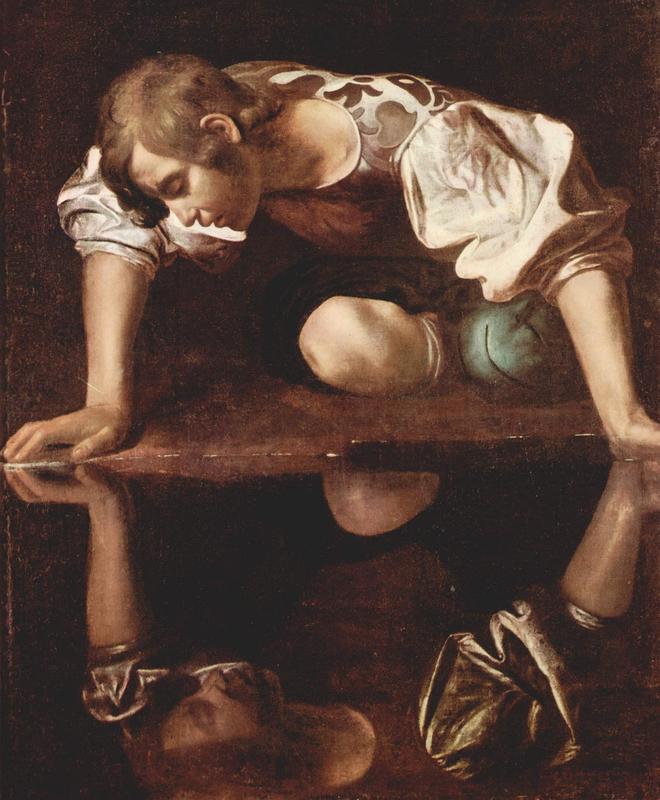More about Narcissus
- All
- Info
- Shop

Contributor
Baroque painter Caravaggio takes on a Roman myth written by the poet Ovid.
The term narcissism and the name for the yellow narcissus flower (more commonly known as a daffodil) originates from the Greco-Roman myth of Narcissus, a young man who fell so deeply in love with his own image that he died in an attempt to grasp his beloved. In society today, we’ve become desensitized to the pitfalls of narcissistic tendencies because of the prevalence and impact of social media, particularly Instagram culture. But long before the rise of the “influencer,” the story of Narcissus warned the public of the dangers of egotism.
The young man bends before a glassy spring to drink some water, as the Roman poet Ovid’s iteration of the story goes, “as he stooped to quench his thirst another thirst increased.” Our boy Narcissus turned out to be a thirsty HOE. Upon sight of his own reflection in the water, “he cannot move, for so he marvels at himself.” He was feeling himself a little too hard. When Narcissus fatefully leaned down to kiss the beautiful face he saw in the water, he fell to his untimely death into the stream and drowned. While he remained in the Underworld, marveling at his own reflection in the river Styx eternally, “a sweet flower grew, golden and white, the white around the gold,” in his body’s place.
Baroque painter Caravaggio’s depiction of this motif dramatises the story by focusing on its pivotal moment: Narcissus’s love at first sight with the image reflected on the water’s surface. Artists realized the gravity of manipulating reflections of the world, and explored this sentiment in their work. Reflections were thought of as a parallel of painting portraits, and the responsibility of representation was a particular challenge of the artist. Depictions of mirrors became increasingly common during this period of art history. The mirror “thematizes the act of painting, suggesting a combination of colors deployed on a surface to create an illusion.”
As a very dramatic yet brilliant former professor of mine once said regarding this painting, the imperfect circle of the arms “erupts in a bodily, visceral kneecap, the phallic, tumescent flesh of the kneecap.” The dramatized lighting and stark contrast between light and dark makes that big, round kneecap thrust out toward the viewer as well as his own reflection in the water. By making the focal point of the canvas this glorious kneecap, Caravaggio paints the autoerotic overtones of the story.
A friend of Caravaggio’s suggested that this image represented the artist’s own narcissism. The artist, in using a classical story as his subject, may have intended to “outdo the pompous classicist masters.” Maybe all along Caravaggio’s depiction of Narcissus was actually a self-portrait.
Sources
- Baker, George. "No More Play." Art History 129C: Surrealism. Class Lecture, UCLA, Los Angeles, CA, 2018.
- Harris, Beth, and Steven Zucker. "Caravaggio, Narcissus at the Source." Khan Academy. https://www.khanacademy.org/humanities/monarchy-enlightenment/baroque-a….
- Ovid. "Echo and Narcissus." In Metamorphoses.
- Posèq, Avigdor W. G. "THE ALLEGORICAL CONTENT OF CARAVAGGIO'S "NARCISSUS"." Source: Notes in the History of Art 10, no. 3 (1991): 21-31. http://www.jstor.org/stable/23203015.
- Wilson, Bronwen. "The Mirror." Art History 22: Renaissance and Baroque Art. Class Lecture, UCLA, Los Angeles, CA, 2016.
Featured Content
Here is what Wikipedia says about Narcissus (Caravaggio)
Narcissus is a painting by the Italian Baroque master Caravaggio, painted circa 1597–1599. It is housed in the Galleria Nazionale d'Arte Antica in Rome.
The painting was originally attributed to Caravaggio by Roberto Longhi in 1916. This is one of only two known Caravaggios on a theme from Classical mythology, although this is due more to the accidents of survival than the artist's oeuvre. Narcissus, according to the poet Ovid in his Metamorphoses, is a handsome youth who falls in love with his own reflection. Unable to tear himself away, he dies of his passion, and even as he crosses the Styx continues to gaze at his reflection (Metamorphoses 3:339–510).
Check out the full Wikipedia article about Narcissus (Caravaggio)















Always enlightening! Another great read!